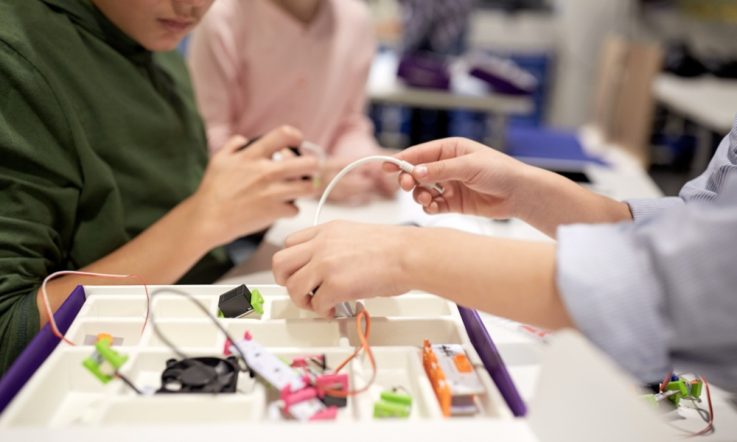A new research report says it's time to 'join the dots' and scale up successful examples of flexible learning systems to meet the 21st Century education needs of all Australian school students.
The Case, released by the Dusseldorp Forum, brings together the findings of national consultations, a review of research evidence, and a review of current education policy and practice.
The independent philanthropic foundation highlights the fact that one in five high-school-aged students in Australia are currently not attending school. It adds although retention rates to Year 12 have increased, recent research shows 21 per cent of youngsters leave school in Australia without a Year 12 qualification.
The foundation estimates more than 600 000 students in the high school age group could benefit from more flexible and inclusive learning approaches; and the good news is there are already plenty of examples of effective practice across the country to build on.
'There are at least 900 flexible and inclusive learning programs in Australia, and we know what it is about these approaches that work,' Teya Dusseldorp, Executive Director at Dusseldorp Forum, says.
The Case showcases several examples of successful approaches. These include:
Rooty Hill High School in New South Wales: '... it demonstrates what can happen when educators recognise student diversity and local opportunity and start exactly where their own students are at,' the report says. 'By recognising the characteristics of the local community and the student population, the whole of learning then can become more accessible to students.'
The school, in Western Sydney, teaches Chinese perspectives across the curriculum through Asian literacy and cultural immersion in Year 7, a community outreach program in Year 8, and a Higher School Certificate in Mandarin. '[The approach] now supports an ongoing outreach program with the partner primary schools, the study of Mandarin in the school, a teaching assistant who is a fully qualified teacher trained in China, and a cultural excursion and exchange program to China for students, parents and teachers.'
In Tasmania, the Beacon Program at Cressy District High School (CDHS) is engaging students by offering real world links and experiences such as mock interviews, try a trade, career and industry tours and industry expos run by the students themselves.
'The number of CDHS students continuing their training and education beyond Year 10 increased from 58 per cent in 2009, to 72 per cent in 2010, to 86 per cent in 2011 and to 97 per cent in 2013,' the report notes.
A pilot program supporting 90 Aboriginal and Torres Strait Islander high school students in New South Wales, Victoria and Western Australia is also featured. The Aspiration Initiative's (TAI) Academic Enrichment Program organises academic enrichment camps and ongoing support such as tutoring, mentoring and work experience.
'Foundational to the program is the assertion that cultural identity is a positive influence that motivates, enhances and supports high level academic achievement. ... Whereas, nationally, only three in 100 Year 8 Indigenous students are eligible (on the basis of their marks) to go to university when they finish school, 61 per cent of TAI students are currently on a Year 12 ATAR pathway.'
At the Edmund Rice Flexible Learning Centre in Townsville, Queensland, all students have a personal learning plan that includes a focus on literacy and numeracy, life skills, vocational learning and project-based learning.
In Redfern, New South Wales, Youth Off The Streets' Key College is an independent high school supporting 14- to 18-year-olds who are either homeless or have unstable accommodation. Like the Flexible Learning Centre in Townsville, each student has an individual learning plan. 'The Year 10 attendance rate in 2011 was 74 per cent,' the report says. 'In the 2012 annual [Youth Off The Streets] online survey, 87.9 per cent of young people thought that the program had helped them to "achieve things I didn't think I could".'
The NETschool campus of Victoria's Bendigo Senior Secondary College (BSSC) is seen as another successful example of a flexible learning model - catering for 15- to 19-year-olds who are unable to attend mainstream schooling. Students work with mentors to create individual learning plans and undertake research-based learning - making study choices based on projects of personal interest.
South Australia's Innovation Community Action Network (ICAN), which offers flexible learning options outside mainstream schooling but still under the responsibility of a school principal, and CARE Schools in Western Australia, which focuses on practical learning to support the transition to further training and employment, also feature in the report.
Co-authors Dr Ani Wierenga and Jo Taylor say the successful programs have all been tailored to match the needs of learners, in a local context.
'As demonstrated in this report, there is a great body of practice knowledge, good evidence of successful programs and strong learning cultures, and, increasingly, states (governments) are adding systemic supports.
'[It's time to] pull all this evidence together, to use what we know, to work collectively to make change, and to create systems that work.
'Isolated case studies of success will remain just that until the dots are joined.'
References
Wierenga, A., & Taylor, J. (2015). The Case for Inclusive Learning Systems: Building More Inclusive Learning Systems in Australia. Sydney: Dusseldorp Forum.
Is your school running a flexible learning program?
How are you monitoring its impact on student learning outcomes?
Has the program contributed to retention rates?
Share your story with Teacher by emailing teachereditor@acer.edu.au



